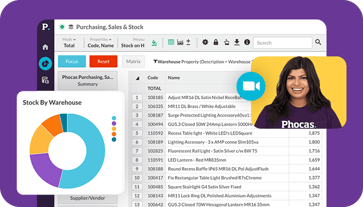Can business intelligence bring sales and marketing together?
Is it time to call a truce between sales and marketing?
For as long as businesses have been selling products and services, there has been a rift (some may call it gaping crevasse) between sales and marketing. Despite playing for the same team, sales has often questioned whether marketing really understands how to generate leads, while marketing wonders whether sales is actually working hard enough to close the leads they receive.
In reality, they need each other because alignment makes a major difference in overall business success. In fact, Aberdeen Research found that companies that are best in class at aligning marketing and sales experienced an average of 20% growth in annual revenue. Businesses with unaligned sales and marketing teams actually had a four percent decline.
The difference is too significant to ignore. Fundamentally, sales and marketing have approached the business from different angles, which makes alignment challenging. It’s why Forrester found that only 8% of B2B companies have actually achieved sales and marketing nirvana.
A singularity of purpose
In an ideal world, sales and marketing are on the same page and every department in the company has an interest in every customer. In an aligned business, there is ongoing communication, a method for providing feedback for how marketing generates leads and how sales pursue them.
Alignment is “more concerned with giving both teams a singularity of purpose and the ability to collaborate through open communication, shared data, and shared deliverables.”
Simply stated, an integrated sales and marketing force means a stronger company.
So how do we get there?
Driving alignment with shared data
There are a variety of things that can be done to improve alignment, from using a consistent language for sales and marketing and holding regular meetings to establishing formal service-level agreements and sharing common goals. One of the key drivers is shared data, specifically putting in place a common set of metrics across the entire sales process. While this goes against the grain in terms of how sales and marketing approach the business, the core metrics will provide a more unified view to push the “singularity of purpose.” Managing the core metrics and providing the visibility into the data and sales process is the strength of business intelligence.
Things such as leads generated, leads moved to marketing qualified, leads moved to sales qualified, meetings and deals won might be a typical sales process. Business intelligence can measure this quantitative data across the sales cycle and provide a shared, centralized access point or dashboard that allows sales and marketing to measure the effectiveness of lead generation campaigns and return on investment, as well as ways to improve.
A unified view of the business
Business intelligence provides the accountability for action, evidence of the effort, and the validation of value that each group brings to the business. Traditionally, marketing and sales have operated in silos, but BI makes it possible to integrate data from a variety of disparate resources, including major ERP and CRM systems, as well as marketing automation and cloud-based solutions.
When a singularity of purpose is clear, business intelligence can serve as the olive branch between sales and marketing, helping the teams achieve their individual goals, while moving the business forward.


Empowering businesses with intuitive data analytics, driving informed decisions for growth and profitability. We make people feel good about data.
Related blog posts

How can you maximize the business benefits from your enterprise resource planning (ERP) system? You get there by rethinking ERP reporting as a layered reporting system that turns ERP data into real-time insights, not just historical outputs. For years, enterprise resource planning platforms have been the backbone of manufacturing, distribution and retail because they capture orders, inventory, invoices and financial data in one place. Yet the price and effort of implementing ERP software has often led business people to question whether the company is getting the value they expected. It depends on how well people can access, analyze and act on the information inside the ERP system and related data sources.
Read more
Customer segmentation has been around for decades, but in many organizations, it’s still underutilized. Done right, it’s one of the most powerful tools to help sales teams focus their time and energy, optimize resources and improve the customer experience.
Read more
Picture a football coach preparing for the big game. He watches game‑tape, studying player metrics, analyzing every play and using real‑time stats to inform strategy. That’s exactly how sales managers and sales leaders should approach their coaching program—with a data‑driven approach.
Read more
Sales professionals operate in face-paced environments with savvy customers who have a lot of choice. Whether you're in B2B sales or working with consumers, the sales process is challenging with longer sales cycles, more decision-makers and higher expectations for follow-up and advice. To stay competitive, sales reps and sales teams need the best sales tools to reduce administrative tasks and improve sales team performance.
Read moreBrowse by category

Find out how our platform gives you the visibility you need to get more done.
Get your demo today